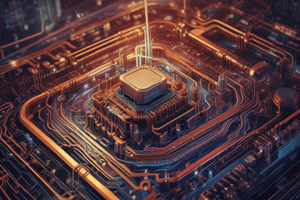Podcast
Questions and Answers
What distinguishes a thyristor from a normal diode?
What distinguishes a thyristor from a normal diode?
- A thyristor can only control DC current.
- A thyristor has two terminals compared to a diode's three.
- A thyristor can conduct current in both directions at all times.
- A thyristor requires a gate signal for operation. (correct)
What is a characteristic feature of an SCR when used in a motor starter?
What is a characteristic feature of an SCR when used in a motor starter?
- It functions as a simple rectifier circuit.
- It directly controls the frequency of the AC supply.
- It maintains a constant frequency while varying voltage output. (correct)
- It operates without any external controlling mechanism.
Which application of SCR involves altering the speed of an electrical motor?
Which application of SCR involves altering the speed of an electrical motor?
- Converter circuits
- Variable Frequency Drives (VFD) (correct)
- Basic rectification in household devices
- Lighting control circuits
What mechanism is necessary for an SCR to turn on?
What mechanism is necessary for an SCR to turn on?
How does the pulse amplitude affect the operation of a thyristor?
How does the pulse amplitude affect the operation of a thyristor?
What is the primary structural difference between a thyristor and a conventional bipolar transistor?
What is the primary structural difference between a thyristor and a conventional bipolar transistor?
Which statement accurately describes the process of turning a thyristor ON?
Which statement accurately describes the process of turning a thyristor ON?
What is a significant advantage of using silicon for thyristors compared to other semiconductor materials?
What is a significant advantage of using silicon for thyristors compared to other semiconductor materials?
Which of the following best describes the OFF mechanism of a thyristor?
Which of the following best describes the OFF mechanism of a thyristor?
In what applications are thyristors particularly beneficial?
In what applications are thyristors particularly beneficial?
Flashcards are hidden until you start studying
Study Notes
Thyristors (SCRs)
- Thyristors are also known as Silicon Controlled Rectifiers (SCRs).
- Thyristors are more advantageous than diodes for rectification.
- Thyristors are turned ON by increasing the gate current.
- Thyristors can be turned OFF by reducing the applied voltage below the holding current.
- Thyristors can achieve both half-wave and full-wave rectification.
- They are particularly useful for controlling power circuits.
- Thyristors are simple to use, affordable, and often easy to build and operate.
Construction of a Thyristor
- A thyristor consists of four layers of differently doped silicon, unlike the three layers of conventional bipolar transistors.
- It has a p-n-p-n structure, with the outer layers forming the anode (p-type) and the cathode (n-type).
- The gate (control terminal) connects directly to the p-type layer adjacent to the cathode layer.
How a Thyristor Works
- Thyristors are unique in their operation.
- In a normal state, no current flows through the device.
- A small gate current is required to "fire" the device and enable conduction.
- Once "fired," the device remains conducting until the supply voltage is removed.
- Thyristors can be considered as two back-to-back transistors: an n-p-n transistor connected to the cathode and a p-n-p transistor connected to the anode.
- The gate is connected to the base of the n-p-n transistor.
Thyristor in Action
- Initially, no current flows through the device as neither transistor is conducting.
- A small gate current turns on the p-n-p transistor (TR2).
- This causes a voltage drop on the collector of TR2 towards the cathode.
- This triggers current flow through the base of the n-p-n transistor (TR1), turning it on.
- The activation of TR1 further reduces the voltage on its collector, sustaining the "on" state of TR2.
- Only a small trigger pulse is necessary to turn on the thyristor.
- Turning off the thyristor requires removing the supply voltage.
- Current flows only in one direction through the thyristor.
- Reverse voltage does not allow current flow, even with gate current applied.
- Thyristors operate only during half of the AC waveform, remaining inactive during the other half.
Applications of Thyristors
- Motor starter (Soft starter):
- Thyristors are used to control the voltage provided to the motor, ensuring a smooth start.
- Varying Motor Speed (VFD):
- Thyristors are used in VFDs to control the motor speed by adjusting the frequency of the AC supply.
- Converter Circuit:
- Thyristors enable the conversion of AC to DC.
- Inverter Circuit:
- Thyristors enable the conversion of DC to AC.
- SCR in Motor Starter:
- The voltage output can be varied while maintaining the same frequency.
- Thyristors serve as voltage limiters during both positive and negative AC cycles.
- The SCR effectively functions as a starting method to reduce the initial current surge of AC motors.
- Once the motor reaches its rated speed, the SCR bypasses the circuit.
- SCR in VFD:
- The frequency of the AC supply is varied, while keeping the voltage constant.
- Thyristors are employed to convert AC to DC and then convert DC back to AC of a variable frequency.
- This enables the control of high-power motors.
Differences between Thyristors and Normal Diodes
- Normal Diodes:
- Two layers (P and N).
- Convert AC to DC in forward bias.
- Thyristors:
- Four layers (P and N).
- Require gate activation for output in forward bias.
Studying That Suits You
Use AI to generate personalized quizzes and flashcards to suit your learning preferences.



